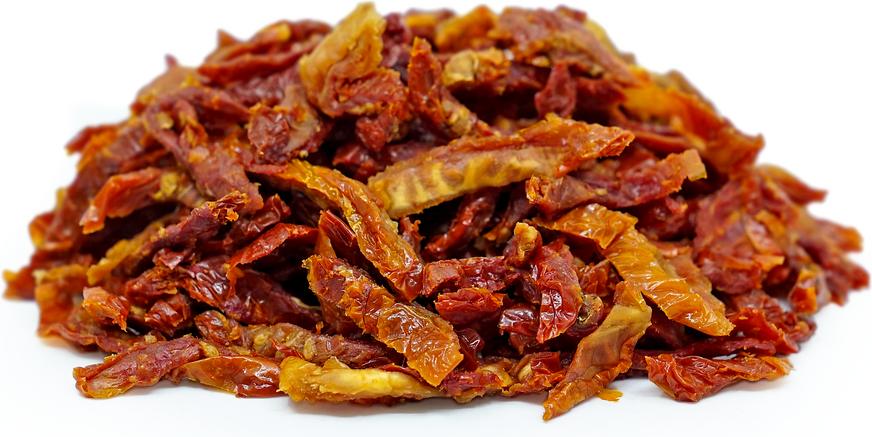


Sundried Tomatoes
Estimated Inventory, 5 lbs : 0
Description/Taste
Sundried tomatoes are tomatoes that have been dehydrated in the sun. Any type can be sundried but smaller varieties like plum tomatoes are more commonly chosen. They may be dried whole, halved, julienned, or diced. The dimensions of Sundried Plum tomatoes are approximately 2.5 by 5 centimeters when halved and 0.5 by 2.5 to 5 centimeters when julienned. Both the skin and flesh remain visible after they've been sundried, taking on a shriveled appearance and reddish-brown hue. Their skin retains some of the shiny glean of fresh tomatoes, though their appearance is notably more matte after extensive sun exposure. Their shriveled flesh has a slightly faded red hue and keeps its seeds intact, either in a circular pattern when halved or lined up in one or two rows when julienned. Sundried tomatoes feel bumpy and somewhat rough to the touch. They have a typical tomato scent with hints of sweetness. Their flavor is sweet and tart with notes of caramel and a chewy texture, making them harder to bite or cut than undried tomatoes.
Seasons/Availability
Sundried tomatoes are available year-round.
Current Facts
The botanical name for Sundried tomatoes is Solanum lycopersicum and they are from the Solanaceae family. The practice of drying tomatoes in the sun comes from Southern Italy, where this varietal is referred to as pomodori secchi. These tomatoes were traditionally salted and preserved with herbs in oil. Sun drying starts by treating the tomatoes with sulfur dioxide to improve quality and placing them in the sun for 4 to 10 days. During this process, the fruits will lose about 88% to 93% percent of their initial weight. Since they decrease in size so much, large yields of fresh tomatoes are required to produce much smaller yields of Sundried. This variety comes in a plethora of colors but red is the most common. Sundried tomatoes can be dried in the oven or a dehydrator and a close watch is required to prevent them from getting too tough or leathery. Used primarily for their culinary values, Sundried tomatoes remain a popular ingredient worldwide.
Nutritional Value
During the sun drying process, tomatoes retain the nutritional value of their fresh counterparts. They remain high in vitamins C and K, nutrients vital for immune support, collagen production, blood clotting, and skin and bone health. This varietal also possesses niacin and manganese, which convert food into energy, promote nerve health, reduce inflammation, and help the metabolism of amino acids, carbohydrates, and cholesterol. Sundried tomatoes are a source of lycopene and fiber that encourage digestion, regulate blood sugar levels, and potentially reduce the risk of sunburn. They provide the body with potassium and copper to regulate fluid balance, muscle contractions, and improve iron absorption. The drying process concentrates the nutrients in Sundried tomatoes, resulting in higher sugar and calorie content per gram compared to fresh tomatoes. Additionally, they are often treated with salt before drying, leading to increased sodium content.
Applications
Sundried tomatoes are typically soaked in oils and herbs before consumption to soften their chewy and sticky texture. Once soaked, they can enhance a variety of savory dishes like casseroles, stews, soups, goulash, vinaigrettes, pasta sauces, omelettes, focaccia breads, frittatas, paninis, and stir-fries. Chop finely with olives for a marinade to serve with fish or mix bits with cream cheese to make a savory spread for crackers. Sundried tomatoes may be sold in the form of pastes or purées. They pair well with pine nuts, capers, artichokes, chili peppers, lemon, limes, avocados, salad greens, chickpeas, mushrooms, sage, goat cheese, ricotta, mozzarella, pancetta, roasted chicken, and shrimp. Alter recipes according to the size of the Sundried tomatoes: if small, add more. To store, refrigerate them in an airtight container where they can last about 6 months.
Ethnic/Cultural Info
Sun drying tomatoes is a popular tradition in the countryside of Southern Italy where it was discovered before other preservation methods like canning and freezing. Italians would arrange slices of garden fresh tomatoes on their rooftops during the summer. This time-consuming practice persisted because it greatly prevented the fruit from composting and gave them a more intensely sweet flavor. Sundried tomatoes were often enhanced with herbs like basil, rosemary, paprika, and garlic and were commonly used in antipasto, the traditional first course in Italian cuisine, during the wintertime when fresh tomatoes were no longer in season.
Geography/History
Sun drying is one of man’s oldest preservative techniques and can be traced back to Ancient Egypt and Mesopotamia. Native Americans devised successful sun drying techniques by using slanted boards, a technique adopted by Spanish explorers who brought it back to Europe. Eventually, this practice became commonplace in Italy and the rest of the Mediterranean region, where the sunny weather allows for an extensive period of production. Other areas with warm, dry climates are also ideal for cultivating Sundried tomatoes. This variety grew in popularity during the 1980s when European products were being imported due to the rise of the Mediterranean diet. By the 1990s, they were seen in cookbooks promoting this healthier regional lifestyle and were sold in specialty stores alongside other Mediterranean ingredients. Sundried tomatoes remain a well-known product that’s sold in grocery stores throughout the world.
Recipe Ideas
Recipes that include Sundried Tomatoes. One
| Proud Italian Cook |
|
Cauliflower Antipasto Two Ways |




